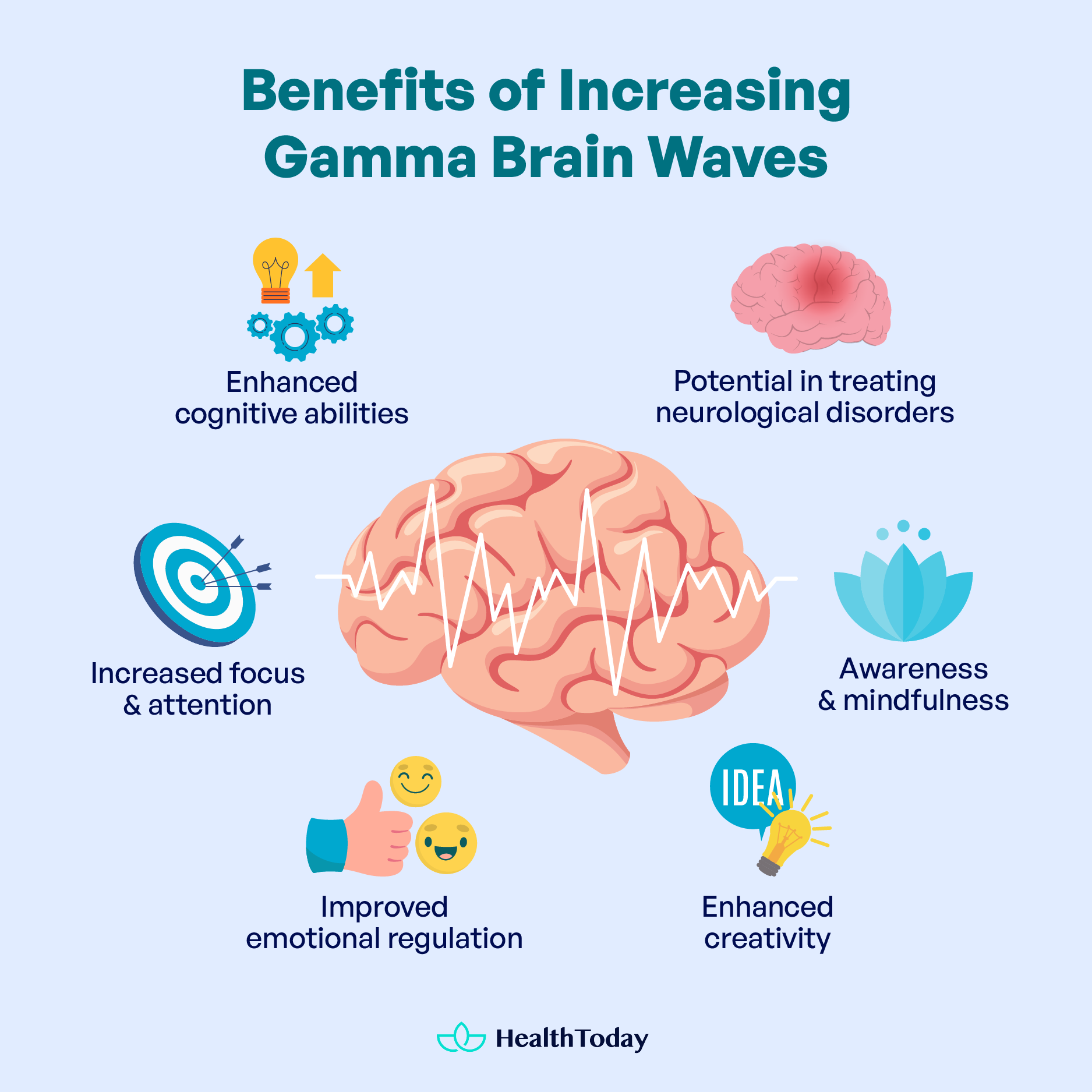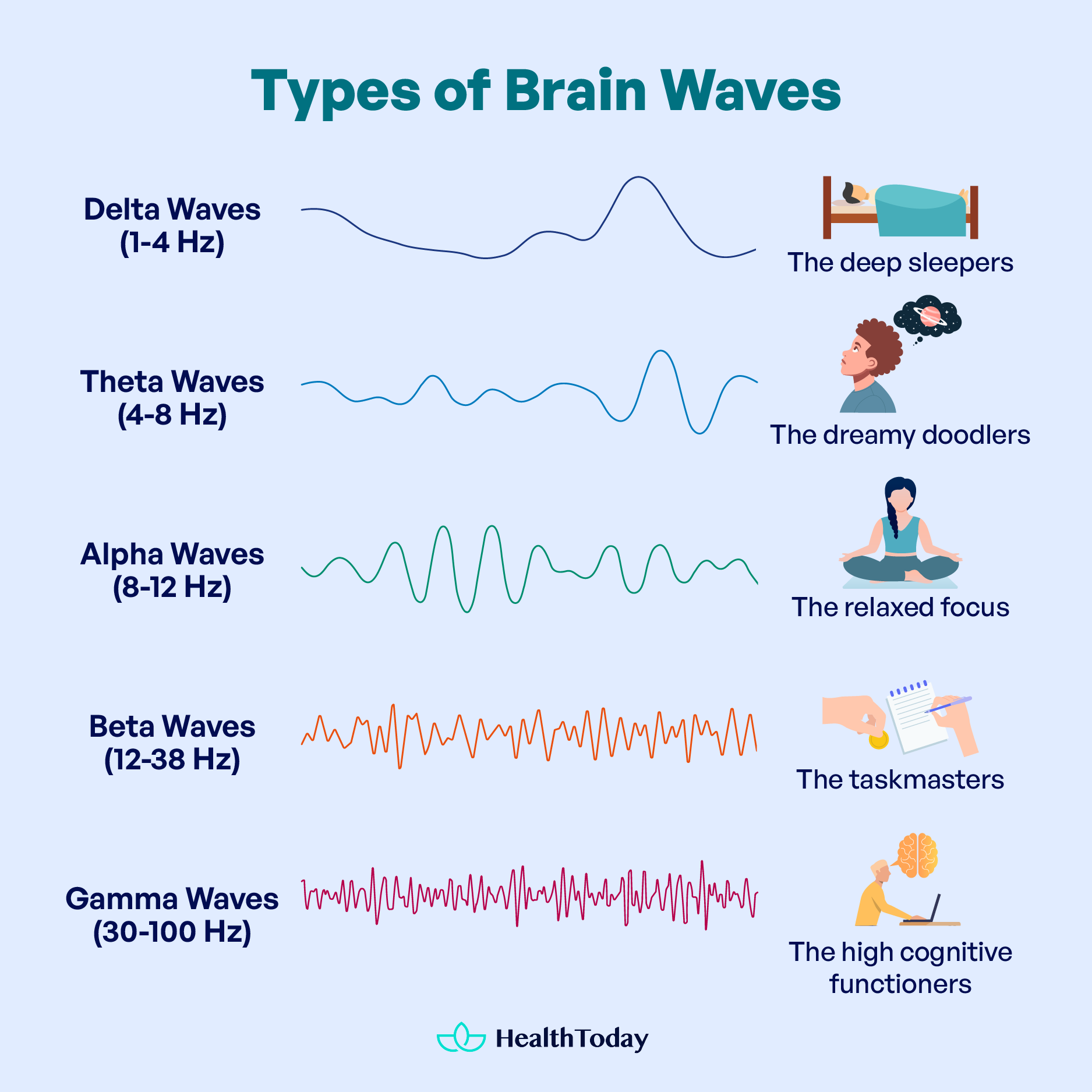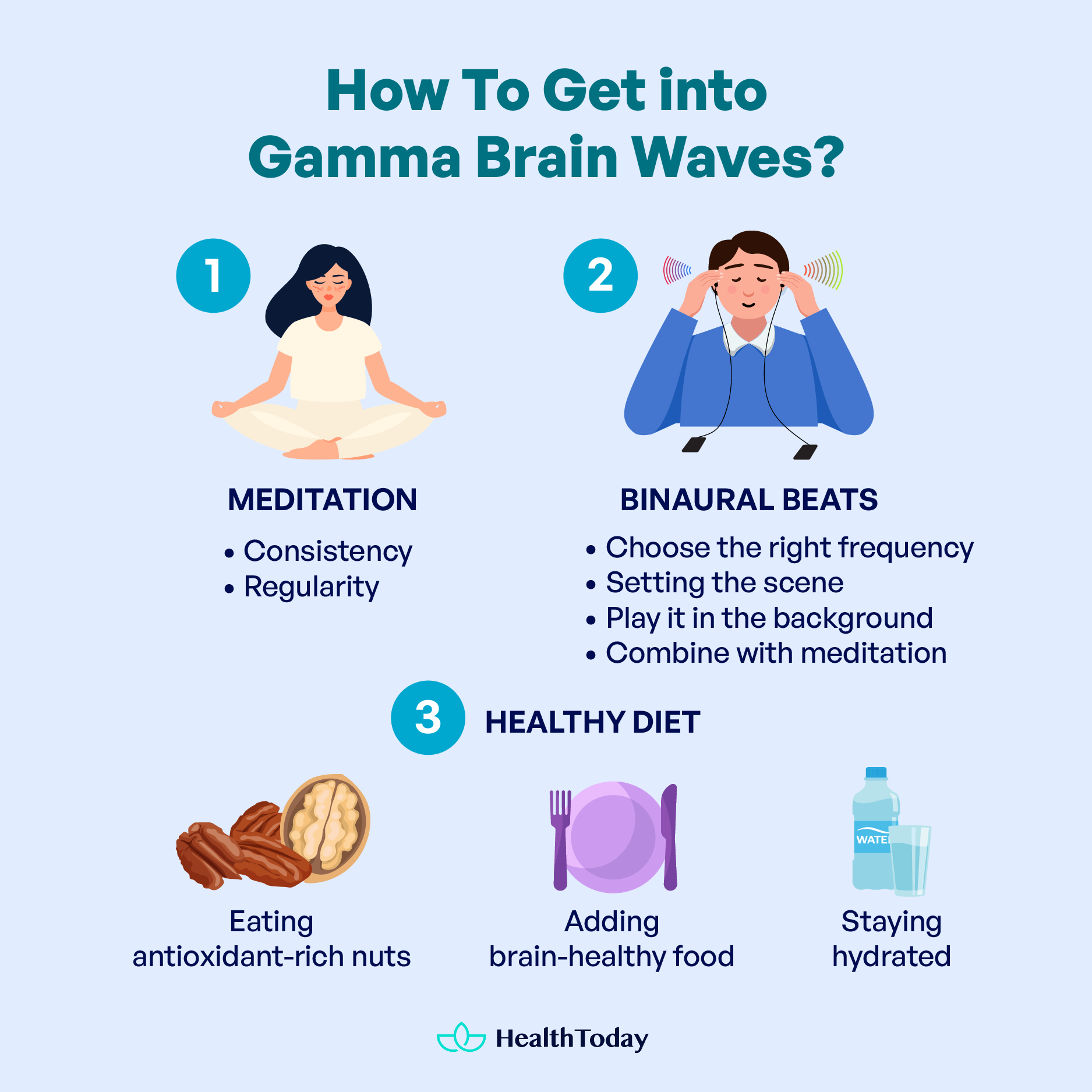Table of Contents
In a world where mental clarity and focus are more valuable than ever, learning how to increase gamma brain waves can be a game-changer. Have you ever imagined possessing the ability to elevate your cognitive functions, enhance memory, and unlock creativity by tweaking the very rhythms of your brain?
In this enlightening journey, we’ll explore how to get into gamma brain waves and unravel the mystery behind these powerful neural oscillations. Join us as we look into simple yet profound strategies to transform your mental health for a more focused and fulfilling life.
What are gamma brain waves?
First, what are brain waves?
Neurons in your brain constantly chat, sending electrical signals back and forth. This neural chit-chat generates patterns and rhythms, which we call brain waves.
Picture them as the ebb and flow of the ocean, each wave differing in speed and strength. We can peek into this ocean of brain activity using technologies like EEG (electroencephalography) and MEG (magnetoencephalography), which, in simpler terms, are like high-tech headbands that listen to your brain’s whispers (1).
Among the brain waves, there are gamma waves. Zipping along at a frequency between 30 and 100 Hertz, they are the fastest brain waves that our neurons produce.
Gamma waves are not just about speed; they’re also a hallmark of high cognitive functioning. People with higher gamma wave activity tend to exhibit superior memory retention and razor-sharp mental processing (2, 3). These waves turbocharge the brain’s ability to process, learn, and remember.
Benefits of increasing gamma brain waves
Understanding the benefits of increasing gamma waves can offer insights into achieving a more balanced and fulfilling life:

1. Enhanced cognitive abilities: Gamma waves play a crucial role in learning and memory. When you increase your gamma waves, you’re likely to focus better, think faster, and remember more (4, 5).
2. Increased focus and attention: Gamma waves are your best friends when you need to concentrate or tackle tough problems. They are prevalent when you are intensely engaged in an activity or when you’re solving complex problems (6).
3. Improved emotional regulation: More gamma wave activity can mean fewer mood swings and less stress. Research shows that increased gamma wave activity can lead to more positive emotional states and less susceptibility to negative moods (7).
4. Enhanced creativity: Some studies suggest gamma waves might be your creative muse. A study found that people who did cyclic meditation had an improvement of gamma waves in the frontal and parietal regions of the brain, which are areas known to be involved in creative thinking (8).
5. Awareness and mindfulness (increase happiness): Long-term meditation practitioners often have higher levels of gamma wave activity. This is no surprise, as meditation promotes mental clarity, mindfulness, and a sense of peace (9).
6. Potential in treating neurological disorders: Research is ongoing into the therapeutic benefits of gamma waves in treating neurological disorders. Studies and reviews have shown positive findings that gamma brain wave entrainment can be a possible future treatment for Alzheimer’s (10).
Other types of brain waves
Besides gamma brain waves, your brain also displays different frequencies, each with its unique characteristics and functions that are crucial in your daily life (1).

Delta waves (1-4 Hz): The deep sleepers
Delta waves are the slow, deep breaths of your brain in dreamless sleep. When you’re in the deepest stages of sleep, delta waves dominate, helping your body to heal and rejuvenate. However, too much delta activity while awake might be linked to challenges like ADHD or learning difficulties. It’s as if your brain is stuck in a sleepy fog, making it hard to focus on the task (11).
Theta waves (4-8 Hz): The dreamy doodlers
Theta waves are your brain’s “daydream” mode. Have you ever found yourself lost in thought or drowsy? That’s theta territory. While these waves are great for creativity and deep meditation, an excess can leave you feeling scattered. It’s like your brain’s wandering through a misty forest of ideas without a clear path.
Alpha waves (8-12 Hz): The relaxed focus
Alpha waves strike a balance. They’re the “just right” brain waves for when you’re awake but relaxed, like taking a peaceful walk. These waves are your brain’s way of staying calm yet alert, perfect for learning and mind-body coordination. Imbalanced alpha in certain brain regions can relate to depression or social withdrawal (12).
Beta waves (12-38 Hz): The taskmasters
Beta waves are your brain in “go mode.” They kick in during active, focused thinking, problem-solving, or decision-making.
Can I control my brain waves?
The short answer is yes, to an extent.
The concept might sound like something out of a sci-fi novel or a Marvel movie (Professor X), but it’s rooted in decades of neurological research. Let’s dive into this intriguing aspect of brain science.
Let’s review again: what are brain waves? They are electrical impulses in the brain, measured in frequencies, and a continuous conversation between neurons. They dictate everything from your thought processes to your emotional state and even how well you sleep at night.
Now, the center of the matter: can we consciously control these waves? Research suggests that, with the right techniques and practices, you can tune into your brain’s frequency and potentially enhance your mental, emotional, and physical well-being.
In the next part, we’ll dive into some simple strategies to help you boost your gamma brain waves and become focused.
Brain waves are like the ocean’s rhythms, and gamma brain waves are the fastest —key for sharp thinking, memory, and focus. Boosting gamma waves can improve your mind’s abilities, regulate emotions, spark creativity, and help with meditation and neurological conditions like Alzheimer’s. Besides gamma, our brains make delta, theta, alpha, and beta waves, each important for functions ranging from deep sleep to focused thought.
Interestingly, we can learn to control these brain waves, enhancing our overall mental and emotional health.
How to get into gamma brain waves? Three simple strategies
Here are three practical strategies that you can easily incorporate into your daily routine to boost your gamma waves:

Meditation
Meditation is the one that is most proven to boost your brain’s gamma waves.
When you meditate regularly, it’s like tuning a musical instrument; you’re fine-tuning your brain to resonate at a higher, more refined frequency. This tuning enhances your cognitive abilities and emotional states. Various meditation forms, including Vipassana, Himalayan Yoga, and Isha Shoonya, each elevate gamma wave activity in their unique way (13).
One study reveals that even a brief meditation can profoundly and diversely influence brain activity, even among beginners. Notably, they saw an increase of 11% in gamma waves among the participants after their meditation session (14).
Though short-term meditation already does the trick, imagine long-term meditation like investing in a high-yield, long-term bond. The benefits accumulate over time, leading to lasting changes in brain activity, notably an increase in gamma wave activity. It’s a profound, enduring transformation, hinting at the deep impacts of meditation on brain function.
So how do you meditate for focused brainwaves?
The key to meditating for gamma brainwave enhancement is consistency. It’s not about the length of your meditation sessions but the regularity. Even short, daily sessions can lead to significant changes.
Trying out different meditation techniques can help you chart your unique path. You might discover that a particular style or a mix of styles resonates best with your brain’s natural rhythm.
For example, mindfulness meditation. By focusing on your breath and observing your thoughts without judgment, you’re steering your brain toward a heightened awareness and clarity state.
For meditation beginners, you can try guided meditation. These sessions are crafted to lead you into deeper states of consciousness, helping your brain sail smoothly into higher gamma frequencies.
Remember, the transformation in brain activity through meditation is a gradual process. Stay the course, and you’ll reach your destination.
Binaural beats
A new hot topic of brainwave enhancement is binaural beats.
Binaural beats are like tuning your brain’s radio to a station broadcasting clarity, focus, and heightened cognition. When you listen to two slightly different tones in each ear, your brain perceives a third tone – the binaural beat. It’s a bit like hearing a musical note that doesn’t really exist outside your mind. For example, if one ear hears a tone at 440 Hz and the other at 444 Hz, your brain perceives a beat at 4 Hz.
This phenomenon can encourage your brain to synchronize its activity with the frequency of the binaural beat. It’s a form of neural mimicry – your brainwaves begin to echo the rhythm they perceive.
Binaural beats can target specific frequencies, like tuning into different channels of your mental state. Gamma waves, oscillating at around 30 to 100 Hz, are linked to cognitive enhancement and heightened awareness. Research has proven that binaural beats targeting this frequency can potentially coax your brain into this high-functioning state(15, 16).
How do you tune into gamma waves with binaural beats?
- Choose the right frequency: Your binaural beats should have a frequency difference in the gamma range (30-100 Hz) to target gamma waves. You can find binaural beats materials online, such as YouTube.
- Setting the scene: Find a quiet place where you can relax without interruption. Use headphones, as binaural beats require separate tones in each ear to create the desired effect.
- Play it in the background: Just like white noise, you can play binaural beats in the background as you work or do tasks that demand focus. After a few minutes, you should feel in the flow state or more focused.
- Combine with meditation: For an enhanced experience, combine binaural beats with meditation. It’s like adding harmonies to a melody, enriching the overall impact on your brain.
However, the effect of binaural beats is personal and subjective.
One study revealed no significant change in memory performance or brain entrainment with gamma-frequency binaural beats (17). While some may find significant benefits, others might notice subtle changes. The key is approaching this tool with an open mind and a willingness to experiment.
Diet
What you eat also impacts the frequency of your brain. And among all foods, nuts emerge as a star ingredient, playing a significant role in enhancing brain health.
Research involving EEG assessments has shown that when participants eat nuts, there’s a notable change in their brain wave frequencies, particularly impacting gamma (31-40 Hz) and delta (1-3 Hz) brain waves (18).
Nuts, pecans, and walnuts, rich in antioxidants, seem to have the most profound impact on increasing gamma and delta brain wave activity. It’s as if these nuts have a direct line to the brain’s control center, enhancing its operations.
However, a brain-healthy diet isn’t just about nuts; it’s about creating a colorful palette of foods.
To improve your brain health, you should include fatty fish like salmon, rich in omega-3s, vibrant berries packed with antioxidants, whole grains for steady energy, and leafy greens for a dose of vitamins. This diet will ensure every part of your brain is well-nourished.
Moreover, remember to stay hydrated. Water plays a vital role in maintaining and supporting brain functions.
Boosting your gamma brain waves is the key to sharper thinking and a focused mind, and it can be done in three easy ways.
- Regular meditation, both short and long-term, improves gamma wave activity, with each method offering unique advantages.
- Binaural beats, which involve listening to two slightly different tones, can also help with cognition, but results may vary.
- A healthy diet, especially eating antioxidant-rich nuts like pecans and walnuts, also affects brain wave frequencies. Adding brain-healthy foods such as fatty fish, berries, whole grains, and greens and staying hydrated can further enhance brain function and focus.
Possible problems with gamma waves
Gamma waves stand out among brain waves for their rapid frequency and association with heightened cognitive functions. However, too much gamma waves can sometimes cause problems.
Your brain is a masterful symphony orchestra, with each type of brain wave representing a different group of instruments: Delta, theta, alpha, beta, and gamma waves, each playing their unique part in this neural concert. However, just like an orchestra can fall out of tune, so can our brain waves.
Stress, lack of sleep, certain medications, and lifestyle factors can throw these waves off balance. This imbalance can lead to cognitive and emotional issues as the brain struggles to maintain its harmonious rhythm.
Gamma waves, the fastest and most nimble of the brain waves, are crucial for high-level brain functions like memory and attention. But when these waves surge too high, they can lead to problems.
A study in 2019 shed light on this phenomenon. Researchers discovered that individuals with mild traumatic brain injuries (mTBI) from combat situations exhibited abnormally high levels of gamma wave activity. It’s as if these brain injuries cranked up the volume of gamma waves, disrupting the brain’s intricate balance (19).
This increased gamma activity was linked to poorer cognitive performance, particularly in executive functioning and visuospatial processing.
At their core, gamma waves are fundamental for sharp cognitive function, yet too much can stir chaos in the workings of our brain. It’s vital to understand that every brain wave type is key to our well-being, and balance is everything.
What foods increase gamma brain waves?
To boost those elusive gamma brain waves, consider incorporating foods rich in omega-3 fatty acids into your diet. Salmon, walnuts, and flaxseeds are your new best friends here. They’re like the brain’s VIP fuel, helping to improve cognitive function and possibly amping up those gamma waves.
What stops gamma waves?
Stress is the archnemesis of gamma waves. High stress levels, especially when chronic, can dampen the brain’s ability to produce these high-frequency waves. So, if you’re looking to cultivate a gamma wave garden in your mind, start by managing stress. Maybe try yoga, deep breathing, or even just laughing more.
How do you reach a gamma state in meditation?
Reaching a gamma state in meditation requires patience and practice. Certain traditions, like Tibetan Buddhism, are known to generate gamma waves. As a beginner, you can start with simpler meditation practices and gradually move to more focused techniques to naturally enhance your brain’s gamma wave production.
Does listening to brain waves work?
Listening to brainwave entrainment audio, like binaural beats, can increase gamma waves for some people. These sounds encourage your brain to synchronize wave patterns with the audio frequencies. However, it’s important to approach them as a supplement to other well-being practices, not as a standalone solution.
Summary
In our journey to learn how to increase gamma brain waves, we’ve found that simple strategies like meditation, binaural beats, and a nut-rich diet can effectively boost our brain’s gamma activity, enhancing focus and creativity.
However, it’s important to maintain a balance, as too much gamma activity can disrupt our mental well-being. Ultimately, increasing gamma waves is about achieving a balanced, harmonious state of mind, where each practice contributes to our overall mental health and fulfillment. Remember, consistently fine-tuning our brain’s activity is the key to a sharper and more vibrant mind.

















Comments
0